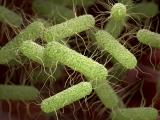Dec 5, 2003 (CIDRAP News) A 1999 outbreak of Salmonella infections scattered over 13 states was traced to Brazilian mangoes, which may have been contaminated when they were treated to kill Mediterranean fruit flies, according to a new study.
The mangoes were dipped in hot water and then in cool water, a procedure that may have caused Salmonella organisms on the surface of the fruit to be drawn inside, says the report by a team of federal and state disease investigators led by Sumathi Sivapalasingam of the Centers for Disease Control and Prevention (CDC). The authors say their report, published in the Dec 15 issue of Clinical Infectious Diseases, is the first of a salmonellosis outbreak involving mangoes.
The outbreak was detected when Virginia health officials noticed that the molecular fingerprints (pulsed-field gel elcectrophoresis [PFGE] patterns) of Salmonella enterica serotype Newport isolates from five patients were identical. About the same time, the CDC noticied a significant national increase in S Newport cases. PFGE analysis subsequently showed that 78 of 494 S Newport isolates reported from November 1999 through January 2000 had matching patterns. Of the 72 case-patients for whom complete data were available, 15 had been hospitalized and 2 had died.
Interviews with the patients revealed that many were Asian or Latino and that 65% had eaten mangoes or cilantro within 5 days before they became ill, according to the report. The case-patients were matched with healthy controls by age and race or ethnicity. A comparison of food exposures for the patients and controls showed that only mangoes were significantly associated with illness.
Four case-patients in three states recalled specifically where they had bought mangoes, the report says. Tracing of those mangoes led to one farm in Brazil. Federal investigators inspected this farm in June 2000 and learned that mangoes bound for the US market were dipped in unchlorinated hot (46.7˚ C) water for 75 to 90 minutes to eliminate fruit flies. The mangoes then were dipped in cool water for a few minutes. "All dip tanks are unenclosed, and toads, birds, and droppings of bird feces were noted in or near the tanks," the report says. Testing of the water used to process the mangoes showed the presence of Escherichia coli and Samonella.
A subsequent study by other investigators, reported at a meeting in 2002, showed that green mangoes "internalized Salmonella when they were first dipped in hot water and then cool water," the report states. The authors note other studies showing that when warm fruit is placed in cool water, gases in the fruit contract and can draw in water and pathogens, which normally would not penetrate the skin.
In other evidence implicating the hot-water treatment, the authors found that mangoes shipped from the Brazilian farm to European had not been not dipped in hot water and that no S Newport outbreak was detected in Europe at the time of the US outbreak. The hot-water treatment replaces fumigation with ethylene dibromide, which is a carcinogen, the article notes.
After the authors' investigation, the US Department of Agriculture (USDA) recommended that mango producers who export to the United States filter and adequately chlorinate their processing water, according to the report. The USDA also ruled that mango processing must include a 30-minute waiting period between hot and cool water dips. The authors note that irradiation is an alternative treatment for eliminating fruit flies and that in 2002 the USDA proposed regulations supporting irradiation treatment for fruits such as mangoes and papayas.
In a commentary accompanying the article, Timothy F. Jones and William Schaffner write that the Salmonella outbreak demonstrates the potential for internalization of pathogens in produce. "No measure of peeling, scrubbing, or soaking in heavily marketed produce disinfectants will eliminate internalized pathogens," they state. In addition, they say, the outbreak "provides yet another demonstration of the importance of advocating the widespread adoption of food irradiation, wherever appropriate." Jones and Schaffner are with the Tennessee Department of Health and the Vanderbilt University School of Medicine in Nashville.
Sivapalasingam S, Barret E, Kimura A, et al. A multistate outbreak of Salmonella enterica serotype Newport infection linked to mango consumption: impact of water-dip disinfestations technology. Clin Infect Dis 2003 Dec 15;37(12):1585-90 [Full text]
Jones TF, Schaffner W. Salmonella in imported mangos: shoeleather and contemporary epidemiologic techniques together meet the challenge. (Editorial) Clin Infect Dis 2003;37(15 Dec):1591-2 [Full text]

















